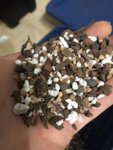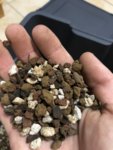Hi
I just saw this thread. If someone had tagged me,
@Leo in N E Illinois I would likely have found this thread sooner. Sorry about the delayed response.
'Earlyblue' and 'Bluecrop' are both Northern Highbush Blueberry cultivars, their genetics are pretty much 100%
Vaccinium corymbosum. This means they are quite winter hardy, flower buds form in late summer, and will survive over winter through -18 F (-27.5 C) on the bushes. The vegetative buds are even more cold hardy, and will survive cold through -20 F. (-29 C) possibly even through -25 F (-32 C). In Virginia, you might have problems with these varieties getting insufficient cold in mild winters. They do need more than 90 days of night time temperatures below 40 F (4 C). They may also be somewhat sensitive to multiple week long episodes of warm days and warm nights where night time temperatures stay above 72 F. (above 20 C). But I don't have hands on experience with this. Both cultivars are known to be pretty hardy and vigorous, they might have no problem at all. It is heat that prevents Northern Highbush types from being grown in Florida, Mississippi or Alabama.
'Earlyblue' was bred to bloom at the same time as 'Bluecrop' but to ripen a week or two earlier. 'Bluecrop' is considered a early main season blueberry, in SW Michigan it has first few ripe fruit usually by July 4, and 50% of the berries are ripe by July 10 or July 15. In your part of Virginia they should come in a few weeks earlier.
The one component in your mix experiments that really does work well for blueberries is bark, fir bark, pine park, any bark will work. Composted for a while (one year, but less is okay). The pumice, perlite & lava are great for adding aeration, they will not shift the pH of the soil much on their own. Akadama and Kanuma are not acidic enough to keep blueberries happy if you have alkaline water. If you are watering only with rain water your mix will be fine. Most municipal water will have some dissolved calcium, the more calcium the bigger the problem for the blueberry. It is the calcium that is the problem, not really the pH. Don't worry about water pH. Do worry about the calcium, expressed most often as Total Alkalinity (as mg calcium carbonate per liter of water). Total dissolved solids can be used to estimate total Alkalinity. Dissolved solids is usually listed as ppm, parts per million.
If you are forced to use medium to hard water (medium to high calcium content) your choice of potting media becomes important. Here peat moss is a good choice. Yes, that fine nasty powdery peat moss sold as Canadian peat. It has the ion exchange capacity to adsorb calcium. It is fine and powdery, no amount of sifting will give you a reasonable amount of peat from a bale, so it will not breathe if compacted. You must repot at least once every other year, and best results might be yearly repotting to keep the peat mix aerated. More in the posts I linked below.
I wrote quite a bit about blueberries over the last 3 years, here are links to all the articles I've written. (I had just summarized them for
@Traken so copy and paste and you have them too.
the How to Increase Soil Acidity For Blueberry is some of my ''most complete'' writing on potting media for blueberry.
https://www.bonsainut.com/threads/how-to-increase-soil-acidity-for-blueberry.37068
This thread I cover pruning for bonsai in detail. My soil recommendations in this thread are not as experienced (or as good) as in the above thread. Ignore the Kanuma in the mix. Peat, Bark & a small amount of Sawdust is my main recommendation post 2018. You will need to repot every 2 years if peat is in the mix. Repotting yearly is okay. I no longer bother to sift the peat.
https://www.bonsainut.com/threads/ideas-suggestions-welcome-blueberry.25620
another thread where I discuss blueberry pruning. A more brief summary, less wordy.
https://www.bonsainut.com/threads/mother-daughter-windswept-blueberry-keep-the-daughter.32266
A thread with photos from the farm and my 2016 version of my blueberry sermon.
https://www.bonsainut.com/threads/blueberry-side-project.23437
https://www.bonsainut.com/threads/berry-bushes-as-shohin-mame.37678
this thread is good discussion of pH, which is much talked about with blueberries and azalea. Point of article, pH is trivial. Calcium content of water and soil is the measurement that matters.
https://www.bonsainut.com/threads/testing-soil-ph.35224/
brief note on Humates, and Seaweed -
https://www.bonsainut.com/threads/vitamin-b-1-drenches-who-does-it.34943
Brief snippets of blueberry knowledge here, some about environmental factors and fungus control page 1. Photos from the farm on page 2.
https://www.bonsainut.com/threads/boredom-leads-to-a-blueberry.28763/page-2#post-554005
more snippets of blueberry info, as I understood it in 2016
https://www.bonsainut.com/threads/blueberry.25150/#post-432088
autumn colors of blueberries, buried in 2 posts in middle of this lengthy thread.
https://www.bonsainut.com/threads/autumn-colours.29452















